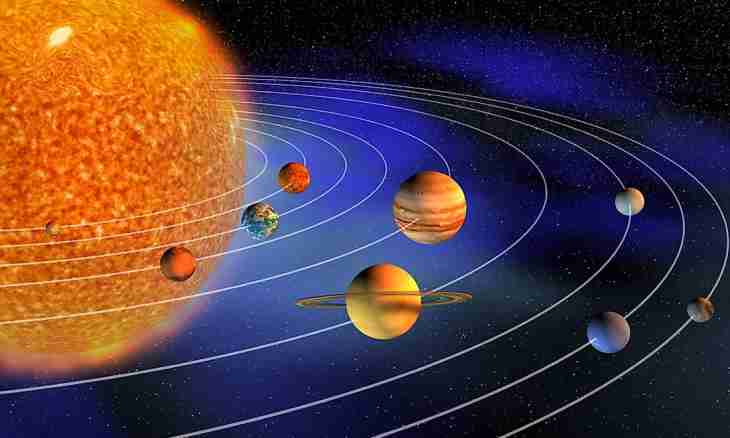The solar system - set of space bodies, interaction between which is explained by laws of gravitation. The sun is the central object of the Solar system. Being from the Sun at different distance, planets rotate almost in one plane, in one direction on elliptic orbits. There was a birth of the Solar system as result of powerful compression of a cloud of gas and dust 4.57 billion years ago.
The sun is the huge heated star which is mainly consisting of helium and hydrogen. On elliptic orbits around the Sun only 8 planets, 166 moon, 3 dwarf planets rotate. And also billions of comets, minor planets, small meteoric bodies, cosmic dust. The Polish scientist and the astronomer Nicolaus Copernicus in the middle of the 16th century described general characteristics and the structure of the Solar system. It changed the opinion occurring at that time that Earth is the center of the Universe. Proved that the center is the Sun. Other planets move around it on certain trajectories. The laws explaining the movement of planets were formulated by Johann Kepler in the 17th century. Isaac Newton, the physicist and the experimenter, proved the law of the world attraction. However to study the main properties and characteristics of planets and objects of the Solar system in detail could only in 1609. Great Galilei invented the telescope. This invention allowed to watch the nature of planets and objects personally. Galilei could prove that the Sun rotates round its pivot-center, observing the movement of solar spots.
Main characteristics of planets
The weight of the Sun exceeds the mass of others almost by 750 times. Force of an attraction of the Sun allows it to keep around itself 8 planets. Their names: Mercury, Venus, Earth, Mars, Jupiter, Saturn, Uranium, Neptune. All of them rotate around the Sun on a certain trajectory. Each of planets has the system of satellites. Before one more planet rotating around the Sun there was Pluto. But modern scientists on the basis of the new facts deprived Pluto of the status of the planet. From 8 planets the biggest is Jupiter. Its diameter is about 142,800 km. It exceeds diameter of Earth by 11 times. Planets, closest being to the Sun, are considered as planets of terrestrial type, or internal. Carry Mercury, Venus, Earth and Mars to them. They, as well as Earth, consist of solid metals and silicates. It allows them to differ from other planets located in the Solar system considerably. The second type of planets - Jupiter, Saturn, the Neptune and Uranium. They are called external, or yupiteriansky planets. These planets represent giant planets. Consist mainly of the melted hydrogen and helium. Practically around all planets of the Solar system satellites rotate. About 90% of satellites are concentrated generally on orbits around yupiteriansky planets. Planets move around the Sun on certain trajectories. In addition they also have a rotation around own axis.
Small objects of the Solar system
The most numerous and small bodies in the Solar system are asteroids. The whole belt of asteroids is located between Mars and Jupiter, consists of objects with a diameter more than 1 km. Congestions of asteroids are called still "an asteroid belt". The trajectory of flight of some asteroids very close passes from Earth. Quantity of asteroids in a belt – to several million. The largest body – the dwarf planet Ceres. It is a block of irregular shape with a diameter in the diameter of 0.5-1 km. The comets consisting mainly of ice fragments belong to a peculiar group of small bodies. They differ from major planets and their satellites in small weight. Diameter of the greatest comets – only several kilometers. But all comets have the huge "tails" surpassing the Sun in volume. When comets close approach the Sun, ice evaporates and as a result of sublimation processes around a comet the dust cloud is formed. The released parts of dust under pressure of solar wind begin to shine. One more space body is the meteor. Getting to Earth orbit, it burns down, leaving the shining mark in the sky. A kind of meteors are meteorites. These are larger meteors. Their trajectory of the movement sometimes close passes near the atmosphere of Earth. Because of instability of a trajectory of the movement the meteors can fall on the surface of our planet, forming craters. One more objects of the solar system are centaurs. They represent the kometopodobny bodies consisting of fragments of ice of large diameter. On the characteristics, the structure and the nature of the movement they are considered as both comets and asteroids. According to all available data from scientific research the Solar system was formed as a result of gravitational collapse. As a result of powerful compression the cloud was formed. Under the influence of gravitational forces, planets were formed of parts of dust and gas. The solar system belongs to the Galaxy the Milky Way and is removed from its center approximately on 25-35 thousand light years. Everywhere in the Universe the systems of planets, similar to the Solar system every second are born. And, very perhaps, in them there are also reasonable beings, similar to us.

